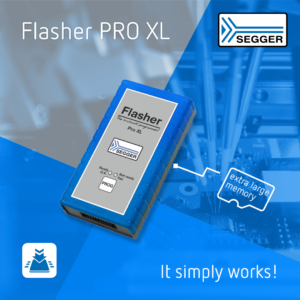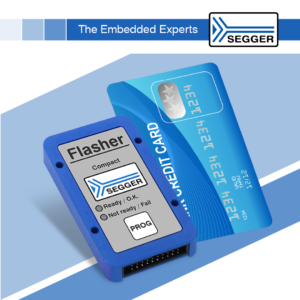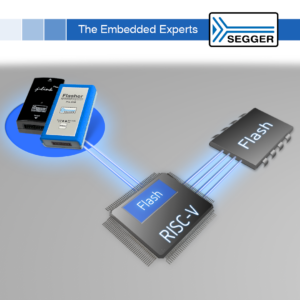The SEGGER Flasher PRO XL is a full-featured, in-circuit, universal flash programming tool with extra-large memory capacity. With 2 gigabytes of storage, the Flasher PRO XL is designed to program large images and/or hold multiple images for use during the production programming process. These can be systems running on Android, Linux, Windows CE, or other […]
segger
Development software supports CMSIS-DAP operation
SEGGER’s latest J-Link software makes it possible to turn J-Link into a high-speed CMSIS-DAP debug probe. In this mode, it can be used with any toolchain or application that is compatible with this standard, such as pyOCD, KEIL MDK, and Arms Development Studio. This mode is available for J-Link BASE, J-Link PLUS, J-Link EDU, J-Link […]
Integrated development environment now handles RE MCUs
Embedded developers can now use SEGGER Embedded Studio IDE with the Renesas RE Family of microcontrollers (MCUs). Embedded Studio is SEGGER’s cross-platform integrated development environment (IDE) for embedded systems development. The editor is quick to start up and the build process is blazingly fast, saving precious working hours. Embedded Studio contains SEGGER’s own runtime and […]
Embedded software tools now supports Raspberry Pi MCU
Microcontrollers are the workhorses powering the digital transformation of our world. RP2040 is the debut microcontroller from the Raspberry Pi Foundation and is now fully supported by SEGGER J-Link. The RP2040 features dual Cortex-M0+ cores, both of which can be programmed and debugged using J-Link. The market-leading performance of J-Link programs the entire RP2040 RAM […]
In-circuit, universal flash programmer features credit-card-sized footprint
The SEGGER Flasher Compact is a full-featured, in-circuit, universal flash programming tool in a housing with a footprint smaller than that of a credit card. While the Flasher Compact can be used in stand-alone or PC-based mode, it is primarily designed for integration into production rigs or automated test equipment (ATE) where space is limited. […]
IDE handles Apple M1 ARM-based SoC work
SEGGER announces its Embedded Studio build for the newly released Apple M1, Apple’s first ARM-based system-on-chip (SoC) designed specifically for Mac. Embedded Studio is SEGGER’s cross-platform Integrated Development Environment (IDE) for ARM/Cortex and RISC-V. While the ARM-based M1 can execute applications for Intel x86-based CPUs using Apple’s Rosetta 2 translator, applications built specifically for the […]
Tool helps write RISC-V flash loaders fitting in 2kB of RAM
SEGGER just released a new Open Flashloader for RISC-V systems. The template, which can be adjusted to fit any RISC-V system, allows engineers to write flash loaders that fit into just 2kB of RAM. This enables J-Link to debug probes to download directly and easily into the flash memory of a RISC-V Microcontroller or SoC. […]
Debug interface hardware now available for Linux on ARM
SEGGER’s entire portfolio of J-Link software is now available for Linux on ARM, for both 32-bit and 64-bit platforms. This includes both the command-line programs and GUI tools such as J-Flash, J-Flash SPI, J-Scope, the J-Link Configurator, and the GUI version of the GDB Server. J-Link for Linux on ARM supports the same target devices […]
Flash programmer gets quad-mode capability for QSPI flashes
SEGGER adds quad mode programming for QSPI Flashes to its universal flash programmer, maximizing programming speed for production environments. Flasher PRO ensures that the time gained using 4-pin transfer translates directly to increased productivity. Operating in either PC-based or stand-alone mode, the Flasher PRO reaches the theoretical minimum programming time of the QSPI device itself. […]
J-Link Remote Servers speed embedded system debugging
SEGGER announces that it now operates a worldwide network of J-Link Remote Servers, enabling a user to debug target systems from anywhere in the world at even higher speeds than before. The J-Link Remote Servers are available to every J-Link user at no cost. While using the closest server significantly increases communication speed, customers still […]










